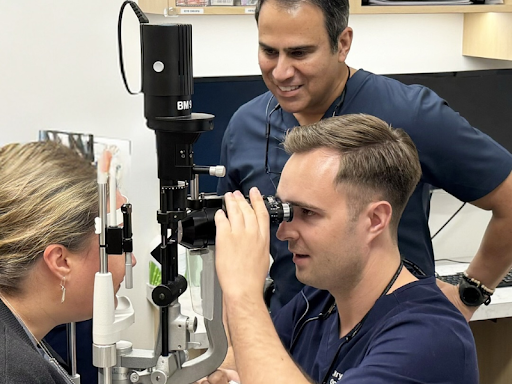Hearing the word glaucoma from your eye doctor can be jarring. Suddenly, your world might feel uncertain, and you may have many questions mixed with some fear. This reaction is completely normal.
You are now beginning a process of glaucoma management, which is all about protecting the precious sight you have. You are not alone in this, and taking control starts with understanding the condition. The purpose of managing glaucoma is to slow its progression so you can continue living your life fully.
So, what is happening inside your eye? Glaucoma often involves high pressure inside your eye, known as intraocular pressure or IOP. This pressure can slowly damage the optic nerve, the main cable connecting your eye to your brain.
This is why glaucoma is sometimes called the silent thief of sight. The damage occurs so gradually that you might not notice any glaucoma symptoms until the condition is significant. With a good plan, you can halt its advance.
What Exactly Is Glaucoma? (And Why Does It Matter?)
Glaucoma is a group of eye conditions that damage the optic nerve. A healthy optic nerve is vital for good vision. Over time, elevated pressure inside the eye wears down these delicate nerve fibers.
This pressure builds when the aqueous humor, a clear fluid produced by the ciliary body, does not drain properly. In a normal eye, this fluid flows through the anterior chamber and out via the trabecular meshwork. If this drainage angle is blocked or inefficient, pressure rises, harming the optic nerve head.
When these nerve fibers are damaged, you can start to develop blind spots in your vision. These spots often begin in your peripheral, or side, vision. Because your brain is so good at filling in the gaps, you may not be aware of this vision loss at first, leading to issues like blurred vision over time.
The aim of managing glaucoma is not to reverse existing damage. Instead, the focus is entirely on preventing more damage from occurring and preserving your remaining vision. Protecting the retinal nerve fiber layer is the primary objective of every treatment.
Your First Steps in Glaucoma Management
After a diagnosis, you will work closely with your eye care team. This is a partnership. Your role is just as important as your doctor’s.
The first step is a series of tests to get a clear baseline of your eye health. This helps your doctor understand the current state of your eyes and track any changes over time. These tests are painless and provide crucial information about your condition.
It’s possible your doctor may initially classify you as a glaucoma suspect. This means you have a risk factor, such as ocular hypertension or a suspicious-looking optic nerve, but no confirmed damage yet. Regular monitoring is critical in this stage to catch any progression early.
The Importance of a Comprehensive Eye Exam
Your doctor will do more than just check your vision with an eye chart. A glaucoma workup involves several specific tests. One is tonometry, which measures your intraocular pressure (IOP); this is the test that uses a puff of air or a small probe that gently touches your eye.
A dilated eye exam allows for a detailed look at your optic nerve. The doctor uses a special magnifying lens to look for signs of damage or changes in its shape and color. Another key part of the eye exam is a visual field test, where you click a button when you see lights flash in your side vision, which maps your peripheral vision and can detect early blind spots.
Advanced imaging tests can also measure the thickness of your retinal nerve fiber layer. These tests provide a quantitative measurement of the nerve tissue, making it easier to detect subtle changes over time. This helps differentiate between a healthy nerve and one showing early signs of damage.
Finding the Right Specialist in Calgary
You will likely be referred to an ophthalmologist, a medical doctor who specializes in eye and vision care. It is important that you feel comfortable with your doctor. You should feel that you can ask them anything about your diagnosis and treatment options.
Do not be afraid to ask questions. How often will I need checkups? What are my specific treatment goals? Feeling informed and part of the decision-making process is a huge part of successful management.
Your eye specialist in Calgary can also direct you to valuable patient resources. These can provide support and additional information about living with glaucoma. A strong support system can make a significant difference in your long-term care.
Medical Treatments: Your Doctor’s Toolkit
The main objective of all glaucoma treatment is to lower the pressure inside your eye for effective IOP reduction. Your doctor has several tools to accomplish this. For most people, treatment begins with the simplest and least invasive options available.
You and your doctor will decide on the best starting point. This decision depends on the type of glaucoma you have, how advanced it is, and your overall health. The treatment plan can always be adjusted as needed based on how your eyes respond.
Prescription Eye Drops: The Front Line of Defense
For most people, this glaucoma medication is the first line of attack. These medicated drops help lower your eye pressure in one of two ways. They either help the fluid drain better, improving aqueous outflow, or they reduce the amount of aqueous humor your eye makes.
Using them correctly and consistently is everything. Skipping doses can let your eye pressure creep back up, putting your optic nerve at higher risk. The American Academy of Ophthalmology explains that making these drops a part of your daily routine, just like brushing your teeth, is vital for success.
There are several different types of eye drops. Prostaglandins are often a first choice for primary open-angle glaucoma, while beta blockers are also very common. Your doctor will choose the one that is best for you, and some people might need to use more than one type to get their pressure down to a safe level.
| Eye Drop Type | How It Works | Common Examples |
|---|---|---|
| Prostaglandins | Increases fluid outflow from the trabecular meshwork. | Latanoprost, Travoprost |
| Beta-blockers | Reduces fluid production by the ciliary body. | Timolol |
| Alpha-adrenergic agonists | Reduces fluid production and increases outflow. | Brimonidine |
| Carbonic anhydrase inhibitors | Reduces fluid production. | Dorzolamide |
Oral Medications
Sometimes, eye drops alone are not enough to lower the pressure. In these cases, your doctor might prescribe a pill. These are usually medications called carbonic anhydrase inhibitors, which work systemically to reduce fluid production in the eye.
Oral medications are typically used for a shorter period. They can have more side effects than eye drops, like tingling in your hands and feet or fatigue. So, your doctor will monitor you closely if you need to take them.
Laser Therapy Options
If drops or pills are not doing the trick, or if you have trouble using drops consistently, a laser procedure is a great option. This is a quick procedure done right in your doctor’s office. It can be a very effective way to treat glaucoma.
A very common procedure is Selective Laser Trabeculoplasty, or SLT. This selective laser treatment targets the trabecular meshwork to help your eye’s natural drainage system work better, which is ideal for open-angle glaucoma. Another procedure is Laser Peripheral Iridotomy (LPI), which is used to prevent or treat angle-closure glaucoma.
The laser peripheral iridotomy creates a tiny hole in the iris. This allows the aqueous humor to flow more freely to the drainage angle. It is a critical intervention for anyone with a narrow angle that puts them at risk for a sudden and painful closure glaucoma attack.
Surgical Options for Glaucoma
When other treatments fail to control eye pressure, surgery becomes the next step. Surgical procedures aim to create a new way for fluid to drain from the eye. These options are typically for people with more advanced or aggressive glaucoma, or for specific types like pigmentary glaucoma.
Minimally Invasive Glaucoma Surgery (MIGS)
A newer category of treatment is minimally invasive glaucoma surgery, or MIGS. These procedures use microscopic-sized devices and tiny incisions to improve fluid drainage from the eye. They are generally safer and have a quicker recovery time than traditional surgery.
MIGS procedures are often performed at the same time as cataract surgery. They work by creating a small bypass through the trabecular meshwork, helping to restore the normal eye drainage system. This approach is becoming a popular choice for people with mild to moderate primary open-angle glaucoma.
Trabeculectomy (Filtering Surgery)
Trabeculectomy is a more invasive form of glaucoma surgery. The surgeon creates a tiny new drainage channel in your eye. This allows fluid to bypass the clogged natural drains and flow out, lowering the pressure.
This creates a small, blister-like pocket, called a bleb, on the white of your eye. It is usually hidden under your upper eyelid, so it is not visible. This pocket acts as a new reservoir for the fluid.
Glaucoma Drainage Devices
Another surgical option is to implant a glaucoma drainage device, sometimes called a shunt or a valve. This involves placing a small, soft tube in your eye. The tube helps drain fluid away to a small reservoir that is placed on the surface of your eyeball, under the eyelid.
This procedure is often used if a trabeculectomy was not successful or is not likely to work. It may also be used for certain types of secondary glaucoma, where other conditions have caused the elevated IOP. It is another effective way to get stubborn eye pressure under control.
Lifestyle and Home-Based Glaucoma Management
What you do every day also plays a role in your glaucoma management. While medical treatment is the foundation, your lifestyle choices can support your overall eye health. Think of it as teamwork between you and your doctor.
Simple daily habits can make a real difference. They empower you and give you a sense of control. These are things you can start doing today to support your vision.
Diet and Exercise
A healthy diet rich in antioxidants is great for your whole body, including your eyes. Some research suggests that foods high in antioxidants, like leafy green vegetables and colorful fruits, might be beneficial. A study published in 2019 pointed to the protective effects of a healthy diet on the optic nerve.
Regular, moderate exercise can also help lower eye pressure. Think brisk walking, jogging, or swimming. It is a good idea to talk with your doctor about your exercise routine, as some activities that put your head below your heart, like certain yoga positions, might not be recommended because they can temporarily increase IOP.
Protecting Your Eyes
Your eyes are already working hard, so give them a little help. Wearing sunglasses that block 100% of UV rays is always a smart move. Sun damage can affect overall eye health over time.
If you play sports or work with tools, always wear protective eyewear. An eye injury is a risk factor that can complicate or worsen glaucoma. It is a simple step that provides a lot of protection.
Managing Other Health Conditions & Risk Factors
Your body is one big connected system. Conditions like high blood pressure and diabetes can affect the blood vessels in your eyes and optic nerve. Managing these conditions is also part of managing your glaucoma.
Make sure all your doctors know about your glaucoma diagnosis. This helps them choose medications for your other health issues that will not interfere with your glaucoma treatment. A complete view of your health is important for good outcomes.
Understanding your risk factors for developing glaucoma is also important. A family history of the condition significantly increases your risk. Other factors include age, ethnicity, and certain medical conditions, which should all be discussed with your doctor.
Conclusion
Receiving a glaucoma diagnosis can feel overwhelming, but it does not have to define your future. You have a dedicated team and a wide range of tools available to help you manage the condition. The single most important factor in your success is your commitment to the treatment plan.
Consistent, lifelong follow-up with your eye doctor is critical. There are many treatment options, from glaucoma medication to minimally invasive surgery, that can control the condition. You can manage your glaucoma effectively and preserve your vision for years to come.
Active and thoughtful glaucoma management can effectively control the condition for most people, helping to protect your vision. You have the power to take charge of your eye health and live a full life. Your active participation is the foundation of success.

















